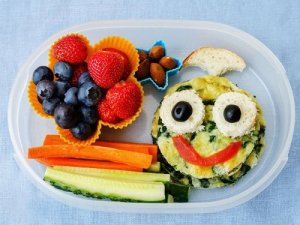Tips to Help Your Child Try New Foods

Children can get fussy easily, refusing to try new foods. This behavior can have many different causes, which we’ll analyze below. In addition, we’ll share a few tips that parents can use to help their child try new foods.
During childhood, children experience many new sensations. As parents, sometimes we’re not as understanding as we should be. We often take things for granted, however, our children deserve our support and attention.
Have you ever asked yourself, how can it be that your child doesn’t want to eat spinach? It’s such a nutritious and tasty vegetable. What you have to do as a parent, is put yourself in your child’s shoes.
Children are constantly discovering new tastes, aromas and textures. It’s perfectly normal for children to find it difficult to adapt to new foods.
Disorders or bad behavior
Parents must know how to differentiate a simple rejection from an underlying problem. There is a behavior called food neophobia, however, it isn’t considered to be a mental disorder. It simply causes children to have difficulties trying new foods.
Food neophobia is a primitive mechanism which causes people to instantly mistrust unfamiliar foods. It can have many different causes such as traumatic experiences (poisoning or chocking). It’s characterized by the rejection of new foods without giving them a chance.
On the other hand, a common occurrence is for children to reject food to express their will. Sometimes children reject new foods “just because.”
In any of these cases, it’s important to be patient and to observe your child’s behavior. Below you’ll find a few tips to encourage your child to try new foods.

How to help your child try new foods
Be creative
Humans are very visual beings. If something we see pleases us, it’s likely that we’ll accept it without further ado. Therefore, it’s wise to “transform” the appearance of certain foods, especially vegetables, in order to get the little ones to eat them.
A good example is to make a fun sandwich with ingredients that make a face. This will make the dish more attractive to your child.
Allow children to participate
We choose our own meals. So why shouldn’t our children have the same right? As parents we can propose healthy alternatives for them to choose from.
Another good idea is to take your children to the supermarket or grocery store in order for them to participate in shopping for healthy foods. This way they’ll be proud of making a contribution. Making children a part of the process can increase their willingness to try new foods.
Small but sure steps
Filling up your child’s plate won’t help if your intention is getting the child to overcome the fear of trying new foods. On the contrary, you should introduce meals step by step.
This can be done through making purées, soups, cakes or sandwiches that contain other ingredients that the child likes. When it comes to fruits, smoothies are a great way to get them to experience new flavors.
“During childhood, children experience new sensations. As parents, we should offer them more understanding.”
Set an example
It would be a big injustice to force children to eat vegetables if we as parents don’t do the same. Therefore, if you want your little one to eat healthy and to adopt healthy habits, the first step you should make is setting a good example.
Be sure to eat in front of your child without complaining. Even without trying, we’re educating our children through our own actions. Your children watch you constantly, since you’re their main role model.
Don’t pressure your child
Exerting pressure, or forcing children to finish their vegetables is the last thing we should do as parents. These practices only reinforce a child’s negative association with certain foods.
In order words, the child thinks: “If I don’t eat this food I don’t like, I won’t be able to play my video games.” This way, healthy foods become an obstacle, an imposition that must be faced unwillingly.

Persist, don’t give up after the first complaint
If your response to your child not wanting to eat a certain food is simply providing other foods, it will be difficult to succeed. As parents we should be patient.
Give your child some time. As we previously mentioned, don’t yell or make a scene if your child doesn’t want to eat.
In conclusion, the main recommendation is to be understanding. Childhood, especially between the age of 2 and 7, is a stage of discovery that each child goes through in his or her own way.
You’ll see that with time and by setting a good example, your child will follow your advice and incorporate a healthy diet.
Children can get fussy easily, refusing to try new foods. This behavior can have many different causes, which we’ll analyze below. In addition, we’ll share a few tips that parents can use to help their child try new foods.
During childhood, children experience many new sensations. As parents, sometimes we’re not as understanding as we should be. We often take things for granted, however, our children deserve our support and attention.
Have you ever asked yourself, how can it be that your child doesn’t want to eat spinach? It’s such a nutritious and tasty vegetable. What you have to do as a parent, is put yourself in your child’s shoes.
Children are constantly discovering new tastes, aromas and textures. It’s perfectly normal for children to find it difficult to adapt to new foods.
Disorders or bad behavior
Parents must know how to differentiate a simple rejection from an underlying problem. There is a behavior called food neophobia, however, it isn’t considered to be a mental disorder. It simply causes children to have difficulties trying new foods.
Food neophobia is a primitive mechanism which causes people to instantly mistrust unfamiliar foods. It can have many different causes such as traumatic experiences (poisoning or chocking). It’s characterized by the rejection of new foods without giving them a chance.
On the other hand, a common occurrence is for children to reject food to express their will. Sometimes children reject new foods “just because.”
In any of these cases, it’s important to be patient and to observe your child’s behavior. Below you’ll find a few tips to encourage your child to try new foods.

How to help your child try new foods
Be creative
Humans are very visual beings. If something we see pleases us, it’s likely that we’ll accept it without further ado. Therefore, it’s wise to “transform” the appearance of certain foods, especially vegetables, in order to get the little ones to eat them.
A good example is to make a fun sandwich with ingredients that make a face. This will make the dish more attractive to your child.
Allow children to participate
We choose our own meals. So why shouldn’t our children have the same right? As parents we can propose healthy alternatives for them to choose from.
Another good idea is to take your children to the supermarket or grocery store in order for them to participate in shopping for healthy foods. This way they’ll be proud of making a contribution. Making children a part of the process can increase their willingness to try new foods.
Small but sure steps
Filling up your child’s plate won’t help if your intention is getting the child to overcome the fear of trying new foods. On the contrary, you should introduce meals step by step.
This can be done through making purées, soups, cakes or sandwiches that contain other ingredients that the child likes. When it comes to fruits, smoothies are a great way to get them to experience new flavors.
“During childhood, children experience new sensations. As parents, we should offer them more understanding.”
Set an example
It would be a big injustice to force children to eat vegetables if we as parents don’t do the same. Therefore, if you want your little one to eat healthy and to adopt healthy habits, the first step you should make is setting a good example.
Be sure to eat in front of your child without complaining. Even without trying, we’re educating our children through our own actions. Your children watch you constantly, since you’re their main role model.
Don’t pressure your child
Exerting pressure, or forcing children to finish their vegetables is the last thing we should do as parents. These practices only reinforce a child’s negative association with certain foods.
In order words, the child thinks: “If I don’t eat this food I don’t like, I won’t be able to play my video games.” This way, healthy foods become an obstacle, an imposition that must be faced unwillingly.

Persist, don’t give up after the first complaint
If your response to your child not wanting to eat a certain food is simply providing other foods, it will be difficult to succeed. As parents we should be patient.
Give your child some time. As we previously mentioned, don’t yell or make a scene if your child doesn’t want to eat.
In conclusion, the main recommendation is to be understanding. Childhood, especially between the age of 2 and 7, is a stage of discovery that each child goes through in his or her own way.
You’ll see that with time and by setting a good example, your child will follow your advice and incorporate a healthy diet.
All cited sources were thoroughly reviewed by our team to ensure their quality, reliability, currency, and validity. The bibliography of this article was considered reliable and of academic or scientific accuracy.
- Chueca, A. S., & Zaragozano, J. F. (2009). Problemas de los niños a la hora de comer. Comedores resistentes y neofobia alimentaria. Boletín de la Sociedad de Pediatría de Aragón, La Rioja y Soria, 39(1), 12-16. https://dialnet.unirioja.es/descarga/articulo/7298876.pdf
- Basantes Criollo, M. E. (2020). La neofobia alimentaria y los hábitos alimenticios en niños y niñas de 2 a 3 años (Bachelor’s thesis, Universidad Técnica de Ambato-Facultad de Ciencias Humanas y de la Educación-Carrera de Educación Parvularia). https://repositorio.uta.edu.ec/handle/123456789/31880
- Maiz, E., Urdaneta, E., & Allirot, X. (2018). La importancia de involucrar a niños y niñas en la preparación de las comidas. Nutrición Hospitalaria, 35(SPE4), 136-139. http://scielo.isciii.es/scielo.php?script=sci_arttext&pid=S0212-16112018000700023
This text is provided for informational purposes only and does not replace consultation with a professional. If in doubt, consult your specialist.








